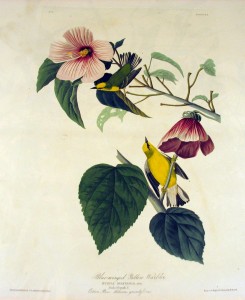 “This pretty little warbler is migratory, and arrives in Louisiana from the South, in the beginning of spring. It is found in open woods, as well as in the vicinity of ponds overgrown with low bushes and rank weeds. Along with a pair of Blue-Winged Yellow Warblers, I have represented a species of Hibiscus, which grows on the edges of these ponds. Its flowers are handsome, but unfortunately have no pleasant odour.
“This pretty little warbler is migratory, and arrives in Louisiana from the South, in the beginning of spring. It is found in open woods, as well as in the vicinity of ponds overgrown with low bushes and rank weeds. Along with a pair of Blue-Winged Yellow Warblers, I have represented a species of Hibiscus, which grows on the edges of these ponds. Its flowers are handsome, but unfortunately have no pleasant odour.
The species which now occupies our attention is a busy, active bird, and is seen diligently searching among the foliage and grasses for the small insects on which it feeds, mounting now and then towards the tops of the bushes, to utter a few weak notes, which are in no way interesting.”
–J. J. Audubon, Ornithological Biography, I (1831), 102.
Comments Off on Audubon “bird of the week”: the Blue-Winged Yellow Warbler
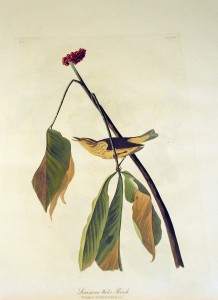 “Much and justly as the song of the Nightingale is admired, I am inclined, after having often listened to it, to pronounce it in no degree superior to that of the Louisiana Water Thrush. The notes of the latter bird are as powerful and mellow, and at times as varied.
“Much and justly as the song of the Nightingale is admired, I am inclined, after having often listened to it, to pronounce it in no degree superior to that of the Louisiana Water Thrush. The notes of the latter bird are as powerful and mellow, and at times as varied.
This bird is a resident of the low lands of the states of Louisiana and Mississippi, and is to be found at all seasons in the deepest and most swampy of our cane brakes, from which its melodies are heard to a considerable distance, its voice being nearly as loud as that of the Wood Thrush. The bird may be observed perched on a low bough scarcely higher than the tops of the canes, in an erect attitude, swelling its throat, and repeating several times in succession sounds so approaching the whole two octaves of a good piano-forte, as almost to induce the hearer to imagine that the keys of that instrument are used on the occasion. The bird begins on the upper key, and progressively passes from one to another, until it reaches the base note, this last frequently being lost when there is the least agitation in the air. Its song is heard even in the winter, when the weather is calm and warm.
[Of the Indian Turnip, upon which this bird is perched] . . . The flowers are green and purple, and the roots are used by Indians as a remedy for colic.”
Comments Off on Audubon “bird of the week,” the Louisiana Water Thrush
 “The bird represented under the name of Bewick’s Wren I shot on the 19th October 1821, about five miles from St. Francisville, in the State of Louisiana. It was standing as nearly as can be represented in the position in which you now see it, and upon the prostrate trunk of a tree not far from a fence. My drawing of it was made on the spot. Another individual was shot a few days after, by a young friend, Joseph R. Mason [see below], who accompanied me on my rambles. In the month of November 1829, I had the pleasure of meeting with another of the same species, about fifteen miles from the place above mentioned . . . it moved along the bars of the fences, with its tail generally erect, looking from the bar on which it stood towards the one next above, and caught spiders and other insects, as it ran along from one panel of the fence to another in quick succession, now and then uttering a low twitter, the only sound which I heard it emit. It occasionally hopped sideways, now with its head towards me, and again in the contrary direction . . . [etc.]
“The bird represented under the name of Bewick’s Wren I shot on the 19th October 1821, about five miles from St. Francisville, in the State of Louisiana. It was standing as nearly as can be represented in the position in which you now see it, and upon the prostrate trunk of a tree not far from a fence. My drawing of it was made on the spot. Another individual was shot a few days after, by a young friend, Joseph R. Mason [see below], who accompanied me on my rambles. In the month of November 1829, I had the pleasure of meeting with another of the same species, about fifteen miles from the place above mentioned . . . it moved along the bars of the fences, with its tail generally erect, looking from the bar on which it stood towards the one next above, and caught spiders and other insects, as it ran along from one panel of the fence to another in quick succession, now and then uttering a low twitter, the only sound which I heard it emit. It occasionally hopped sideways, now with its head towards me, and again in the contrary direction . . . [etc.]
…I have honoured this species with the name of Bewick, a person too well known for his admirable talents as an engraver on wood, and for his beautiful work on the Birds of Great Britain, to need any eulogy of mine.”
CURATOR’S NOTE:
Accompanied by a thirteen year old student of his, Joseph Mason, Audubon sailed on a flatboat from Cincinnati on October 12, 1820. Mason would grow to be one of Audubon’s most important associates in the making of the Birds of America. Of the four hundred and thirty-five paintings, Joseph Mason painted the floral backgrounds in over fifty
Comments Off on Audubon “bird of the week”: Bewick’s Wren
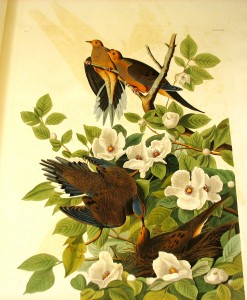 “I have tried, kind reader, to give you a faithful representation of two as gentle pairs of Turtles as ever cooed their loves in the green woods. I have placed them on a branch of Stuartia, which you see ornamented with a profusion of white blossoms, emblematic of purity and chastity.
“I have tried, kind reader, to give you a faithful representation of two as gentle pairs of Turtles as ever cooed their loves in the green woods. I have placed them on a branch of Stuartia, which you see ornamented with a profusion of white blossoms, emblematic of purity and chastity.
Look at the female, as she assiduously sits on her eggs, embosomed among the thick foliage, receiving food from the bill of her mate, and listening with delight
to his assurances of devoted affection. Nothing is wanting to render the moment as happy as could be desired by any couple on a similar occasion.
On the branch above, a love scene is just commencing. The female, still coy and undetermined, seems doubtful of the truth of her lover, and virgin-like resolves to put his sincerity to the test, by delaying the gratification of his wishes. She has reached the extremity of the branch, her wings and tail are already opening, and she will fly off to some more sequestered spot, where, if her lover should follow her with the same assiduous devotion, they will doubtless become as blessed as the pair beneath them.”
Comments Off on Audubon “bird of the week”: The Carolina Turtle Dove
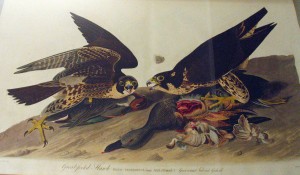 “Look at these two pirates eating their dejeuné à la fourchette, as it were, congratulating each other on the savouriness of the food in their grasp. One might think them real epicures, but they are in fact true gluttons. The male has obtained possession of a Green-winged Teal, while his mate has procured a Gadwal Duck. Their appetites are equal to their reckless daring, and they well deserve the names of “Pirates,” which I have above bestowed upon them.
“Look at these two pirates eating their dejeuné à la fourchette, as it were, congratulating each other on the savouriness of the food in their grasp. One might think them real epicures, but they are in fact true gluttons. The male has obtained possession of a Green-winged Teal, while his mate has procured a Gadwal Duck. Their appetites are equal to their reckless daring, and they well deserve the names of “Pirates,” which I have above bestowed upon them.
The Great-footed Hawk, or Peregrine Falcon, is now frequently to be met with in the United States, but within my remembrance it was a very scarce species in America. I can well recollect the time when, if I shot one or two individuals of the species in the course of a whole winter, I thought myself a fortunate mortal; whereas of late years I have shot two in one day, and perhaps a dozen in the course of a winter. It is quite impossible for me to account for this increase in their number, the more so that our plantations have equally increased, and we have now three gunners for every one that existed twenty years ago, and all of them ready to destroy a hawk of any kind whenever an occasion presents itself.”
Comments Off on Audubon “bird of the week,” The Great-footed Hawk
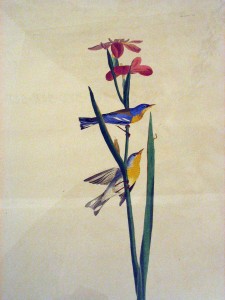 [Male and female]. “This pretty species enters Louisiana from the south as early as spring appears, at the period when most insects are found closer to the ground, and more about water-courses, than shortly after, when a warmer sun has has invited every leaf and blossom to hail the approach of that season when they all become as brilliant as nature intended them to be. The little fellow under your eye is then seen flitting over damp places, such as the edges of ponds, lakes, and rivers, chasing its prey with as much activity and liveliness as any other of the delicate and interesting tribe to which it belongs. It alights on every plant in its way, runs up and down it, picks here and there a small winged insect, and should one, aware of its approach, fly off, pursues it and snatches it in an instant.
[Male and female]. “This pretty species enters Louisiana from the south as early as spring appears, at the period when most insects are found closer to the ground, and more about water-courses, than shortly after, when a warmer sun has has invited every leaf and blossom to hail the approach of that season when they all become as brilliant as nature intended them to be. The little fellow under your eye is then seen flitting over damp places, such as the edges of ponds, lakes, and rivers, chasing its prey with as much activity and liveliness as any other of the delicate and interesting tribe to which it belongs. It alights on every plant in its way, runs up and down it, picks here and there a small winged insect, and should one, aware of its approach, fly off, pursues it and snatches it in an instant.
I have placed a pair of these Warblers on a handsome species of Iris. This plant grows in the water, and in the neighborhood of New Orleans, a few miles below that city, where I found it abundantly, and in bloom, in the beginning of April. Several flowers are produced upon the same stem. I have not met with it anywhere else, and the name of Louisiana Flag is the one commonly given it.”
Comments Off on Audubon “bird of the week,” The Blue Yellow-backed Warbler
 “In Louisiana I found this bird among our cotton fields, where it easily procures the small insects and flies of which its food is entirely composed. It is also found in the prairies along the skirts of the woodlands. I have shot several within a few miles of Philadelphia, in the Jerseys, in a large opening where the woods had been cut down, and were beginning to spring up again. Its flight is light and short, it making an effort to rise to the height of eight or ten yards, and immediately sinking down to the grass or bushes . . . it is one of the first birds that arrives in the spring in Louisiana, and one of the first to depart, being rarely found after the first week of September.”
“In Louisiana I found this bird among our cotton fields, where it easily procures the small insects and flies of which its food is entirely composed. It is also found in the prairies along the skirts of the woodlands. I have shot several within a few miles of Philadelphia, in the Jerseys, in a large opening where the woods had been cut down, and were beginning to spring up again. Its flight is light and short, it making an effort to rise to the height of eight or ten yards, and immediately sinking down to the grass or bushes . . . it is one of the first birds that arrives in the spring in Louisiana, and one of the first to depart, being rarely found after the first week of September.”
Comments Off on Audubon “bird of the week”: The Prairie Warbler
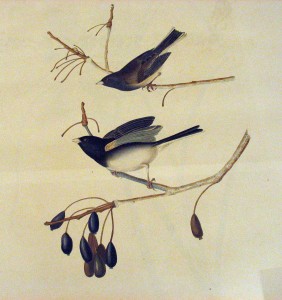 “Although the Snow Birds live in little families, consisting of twenty, thirty, or more individuals, they seem always inclined to keep up a certain degree of etiquette among themselves, and will not suffer one of their kind, or indeed any other bird, to come into immediate contact with them. To prevent intrusions of this kind, when a stranger comes too near, their little bills are instantly opened, their wings are extended, their eyes are seen to sparkle, and they emit a repelling sound peculiar to themselves on such occasions.”
“Although the Snow Birds live in little families, consisting of twenty, thirty, or more individuals, they seem always inclined to keep up a certain degree of etiquette among themselves, and will not suffer one of their kind, or indeed any other bird, to come into immediate contact with them. To prevent intrusions of this kind, when a stranger comes too near, their little bills are instantly opened, their wings are extended, their eyes are seen to sparkle, and they emit a repelling sound peculiar to themselves on such occasions.”
[. . .] “I have seen the Snow Birds far up the Arkansas, and in the province of Maine, as well as on our Upper Lakes. I have been told of their congregating so as to form large flocks of a thousand individuals, but have never seen so many together. Their flesh is extremely delicate and juicy, and on this account small strings of them are frequently seen in the New Orleans market, during the short period of their sojourn [early November to the beginning of spring] in that district.”
Comments Off on Audubon bird of the week (12/19/11), the Snow Bird
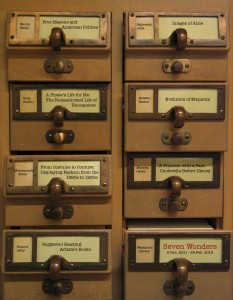 The opening of the student-curated exhibition “Seven Wonders” on December 6 was a great success. Over 50 people braved a dark and rainy Tuesday night to look at the show. Many were also in attendance to pay their respects to Paul Lauter, who spoke movingly about his wife, Ann Fitzgerald (a Trinity professor who died tragically in mid-October), the original instructor of the course.
The opening of the student-curated exhibition “Seven Wonders” on December 6 was a great success. Over 50 people braved a dark and rainy Tuesday night to look at the show. Many were also in attendance to pay their respects to Paul Lauter, who spoke movingly about his wife, Ann Fitzgerald (a Trinity professor who died tragically in mid-October), the original instructor of the course.
The students wrote, designed, and raised money for the production of a full-color 16-page illustrated catalog of the collection, printed in 100 copies. These were sold for a pay-what-you-can donation to Ann’s charities (Doctors without Borders and Amnesty International), for which we collected over $200.
Faculty, staff, students, parents, and other members of the community mingled and chatted as local talent Romulus Perez played classical piano on one of the keyboards we have in the library. After Paul spoke, we visited each exhibit, and its curator said a few words about why she chose her topic, and what items in particular were fascinating or compelling to her.
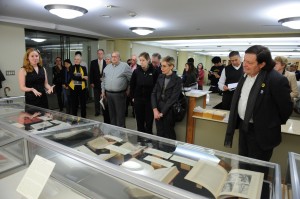 Going forward, this is clearly a model for us to follow. Creating an exhibition is one of the best ways to learn about a topic, and about a collection (its strengths and weaknesses). The librarians need not have all the fun–we will be encouraging students and faculty to be our partners in years to come.
Going forward, this is clearly a model for us to follow. Creating an exhibition is one of the best ways to learn about a topic, and about a collection (its strengths and weaknesses). The librarians need not have all the fun–we will be encouraging students and faculty to be our partners in years to come.
 Missing from the class photo is student Emily Bloom, who could not attend because of a family emergency–you were here in spirit, Emily!
Missing from the class photo is student Emily Bloom, who could not attend because of a family emergency–you were here in spirit, Emily!
Comments Off on Seven Wonders event a success!
 “It was in the month of February 1814, that I obtained the first sight of this noble bird, and never shall I forget the delight which it gave me . . . We were on a trading voyage, ascending the Upper Mississippi . . . I lay stretched beside our patroon. The safety of the cargo was forgotten, and the only thing that called my attention was the multitude of ducks, of different species, accompanied by vast flocks of swans, which from time to time passed us. My patroon, a Canadian, had been engaged many years in the fur trade . . . An eagle flew over us . . . “Look sir! The Great Eagle, and the only one I have seen since I have left the lakes” . . . [he] assured me that such birds were indeed rare; that they sometimes followed the hunters, to feed on the entrails of animals which they had killed, when the lakes were frozen over, but that when the lakes were open, they would dive in the daytime after fish.”
“It was in the month of February 1814, that I obtained the first sight of this noble bird, and never shall I forget the delight which it gave me . . . We were on a trading voyage, ascending the Upper Mississippi . . . I lay stretched beside our patroon. The safety of the cargo was forgotten, and the only thing that called my attention was the multitude of ducks, of different species, accompanied by vast flocks of swans, which from time to time passed us. My patroon, a Canadian, had been engaged many years in the fur trade . . . An eagle flew over us . . . “Look sir! The Great Eagle, and the only one I have seen since I have left the lakes” . . . [he] assured me that such birds were indeed rare; that they sometimes followed the hunters, to feed on the entrails of animals which they had killed, when the lakes were frozen over, but that when the lakes were open, they would dive in the daytime after fish.”
“The name which I have chosen for this new species of Eagle, “The Bird of Washington,” may, by some, be considered as preposterous and unfit; but as it is indisputably the noblest bird of its genus that has yet been discovered in the United States, I trust I shall be allowed to honour it with the name of one yet nobler, who was the savior of his country, and whose name will ever be dear to it. To those who may be curious to know my reasons, I can only say, that, as the new world gave me birth and liberty, the great man who insured its independence is next to my heart. He had a nobility of mind, and a generosity of soul, such as a re seldom possessed. He was brave, so is the Eagle; like it, too, he was the terror of his foes; and his fame, extending from pole to pole, resembles the majestic soarings of the mightiest of the feathered tribe. If America has reason to be proud of her Washington, so has she to be proud of her Great Eagle.”
Comments Off on Bird of the Week, 12/5/11, “The Bird of Washington”
 “Much and justly as the song of the Nightingale is admired, I am inclined, after having often listened to it, to pronounce it in no degree superior to that of the Louisiana Water Thrush. The notes of the latter bird are as powerful and mellow, and at times as varied.
“Much and justly as the song of the Nightingale is admired, I am inclined, after having often listened to it, to pronounce it in no degree superior to that of the Louisiana Water Thrush. The notes of the latter bird are as powerful and mellow, and at times as varied.









